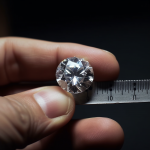Diamond Prices
Read moreX
- X-Group treasure
X-Group treasure refers to a collection of valuable artifacts, often with historical or cultural significance, associated with a particular archaeological discovery or excavation linked to the X-Group.
- X-ray Crystallography
X-ray Crystallography is a technique used to determine the atomic structure of a crystal. In the realm of lapidary, this method aids in understanding the internal arrangement of gemstone crystals.
- X-ray Diffraction
X-ray Diffraction is a technique employed to analyze the crystal structure of materials by exposing them to X-rays. In jewelry, it aids in understanding the composition of gemstones.
- X-ray Fluorescence
X-ray Fluorescence is a method used to determine the elemental composition of materials by bombarding them with X-rays. In the context of jewelry, it aids in identifying gemstone components.
- X-ray Fluorescence Spectroscopy
X-ray Fluorescence Spectroscopy is a method used for elemental analysis in jewelry. It aids in determining the elemental composition of gemstones, contributing to the grading and certification process.
- X-ray Fluoroscopy
X-ray Fluoroscopy is a technique for real-time imaging using X-rays. In lapidary, it aids in dynamic studies of gemstones, allowing for real-time observation of internal structures.
- X-ray Tomography
X-ray Tomography is a technique for imaging the internal structure of objects using X-rays. In lapidary, it aids in studying the internal features of gemstones without damaging them.
- XRF Spectrometer
An XRF Spectrometer is an instrument used for measuring the elemental composition of materials. In the jewelry industry, it plays a crucial role in quality control and gemstone analysis.
- Xanthenes
Xanthenes refer to a group of dyes. While not directly related to jewelry, these compounds have applications in the fashion industry for dyeing fabrics and adding vibrant colors to accessories.
- Xanthite
Xanthite is a mineral or gemstone, known for its distinctive yellow coloration. It may be used in jewelry or other ornamental applications.
- Xanthium
Xanthium is a yellowish mineral, occasionally utilized in jewelry for its distinctive hue. Its use is more niche but adds a touch of uniqueness to certain pieces.
- Xanthochroite
Xanthochroite is a yellow variety of the mineral vesuvianite. It is valued in gemology for its vibrant color, adding a warm and sunny touch to jewelry designs.
- Xenocryst
A Xenocryst is a crystal within a rock that is different from the surrounding matrix. Gemologists study xenocrysts to gain insights into the geological history of gemstone formation.
- Xenogeny
Xenogeny is the formation of gems in foreign rocks, a phenomenon studied in gemology to understand the diverse geological conditions under which gemstones can develop.
- Xenolithic
Xenolithic rocks contain xenocrysts and are studied in gemology to understand the geological processes that lead to the incorporation of foreign crystals in host rocks.
- Xenomorph
Xenomorph is a hypothetical extraterrestrial life form. While not directly related to jewelry, it occasionally inspires avant-garde and sci-fi-themed jewelry designs.
- Xenomorphic Crystal
Xenomorphic Crystals are crystals that lack a definite external shape due to rapid growth conditions. In gemology, these crystals are studied for their unique characteristics and formation.
- Xenophorite
Xenophorite is a green mineral occasionally used in jewelry for its unique color and visual appeal. Its use adds a touch of nature-inspired elegance to certain pieces.
- Xenotime
Xenotime is a rare earth phosphate mineral, known for its typically brown to yellowish appearance. It is often used in jewelry for its unique coloring and rarity.
- Xenotime Yttrium Phosphate
Xenotime is a yellow to brown mineral, often used in jewelry for its unique coloring. It contains yttrium phosphate and is prized for both its aesthetic appeal and geological significance.
- Xerography
Xerography is a method of reproducing images using electrostatic charges. While not directly related to jewelry, it has historical significance in printing techniques.
- Xerophthalmia
Xerophthalmia is a medical condition causing dryness of the eyes. While not directly related to jewelry, it serves as a reminder of the importance of proper jewelry care to avoid irritations.
- Xerophyte
Xerophytes are plants adapted to survive in arid conditions. In the context of ethics and sustainability, the use of xerophyte-inspired materials may be explored in eco-friendly jewelry design.
- Xerophytic Jewelry
Xerophytic Jewelry refers to jewelry inspired by desert plants and environments. It embodies a unique fashion and style, often incorporating elements reflecting the resilience of xerophytic flora.
- Xiphias
Xiphias is an ancient Greek word for sword, sometimes used in jewelry designs to symbolize strength, courage, or historical themes. It adds a touch of symbolism and elegance to certain pieces.
- Xocomecatlite
Xocomecatlite is a rare mineral sometimes used in jewelry for its unique visual properties. Its scarcity contributes to its appeal among collectors and those seeking distinctive pieces.
- Xylography
Xylography is the art of engraving on wood, a technique occasionally employed in jewelry design to create intricate patterns and textures on wooden elements.
- Xylolith
Xylolith refers to fossilized wood used in jewelry. Its use adds a touch of ancient history to jewelry pieces, making them unique and appealing to those with an interest in paleontology.
- Xylonite
Xylonite, also known as "French Ivory," is an early plastic material used in antique jewelry. It was popular during the Victorian era and was often carved into intricate designs.
- Xyston
Xyston refers to a type of ancient Greek spear used in warfare. While not directly related to jewelry, it occasionally inspires designs, particularly in historical or symbolic pieces.
- Xystus
Xystus is an ancient Greek covered portico, not directly related to jewelry but may inspire architectural motifs in certain jewelry designs.



